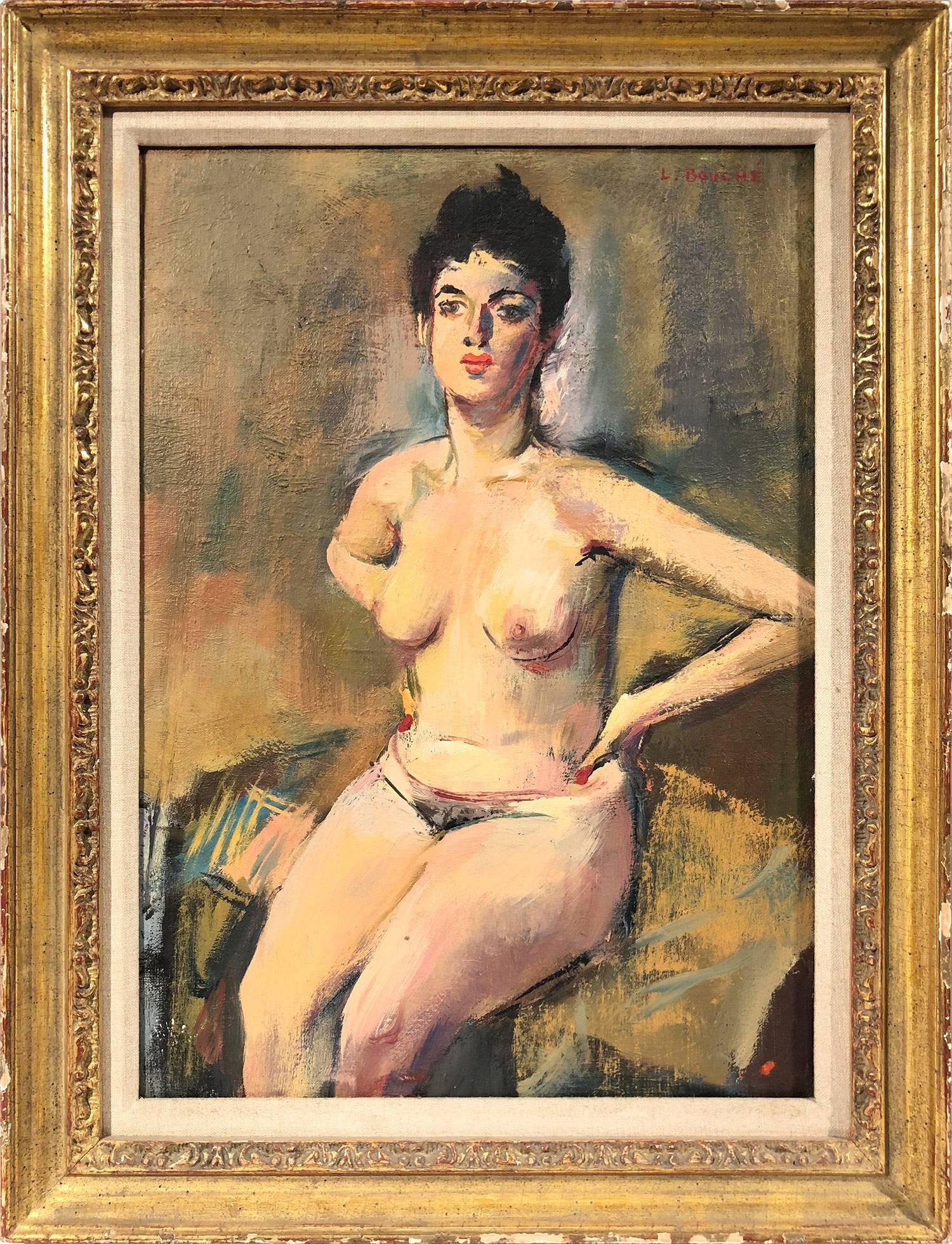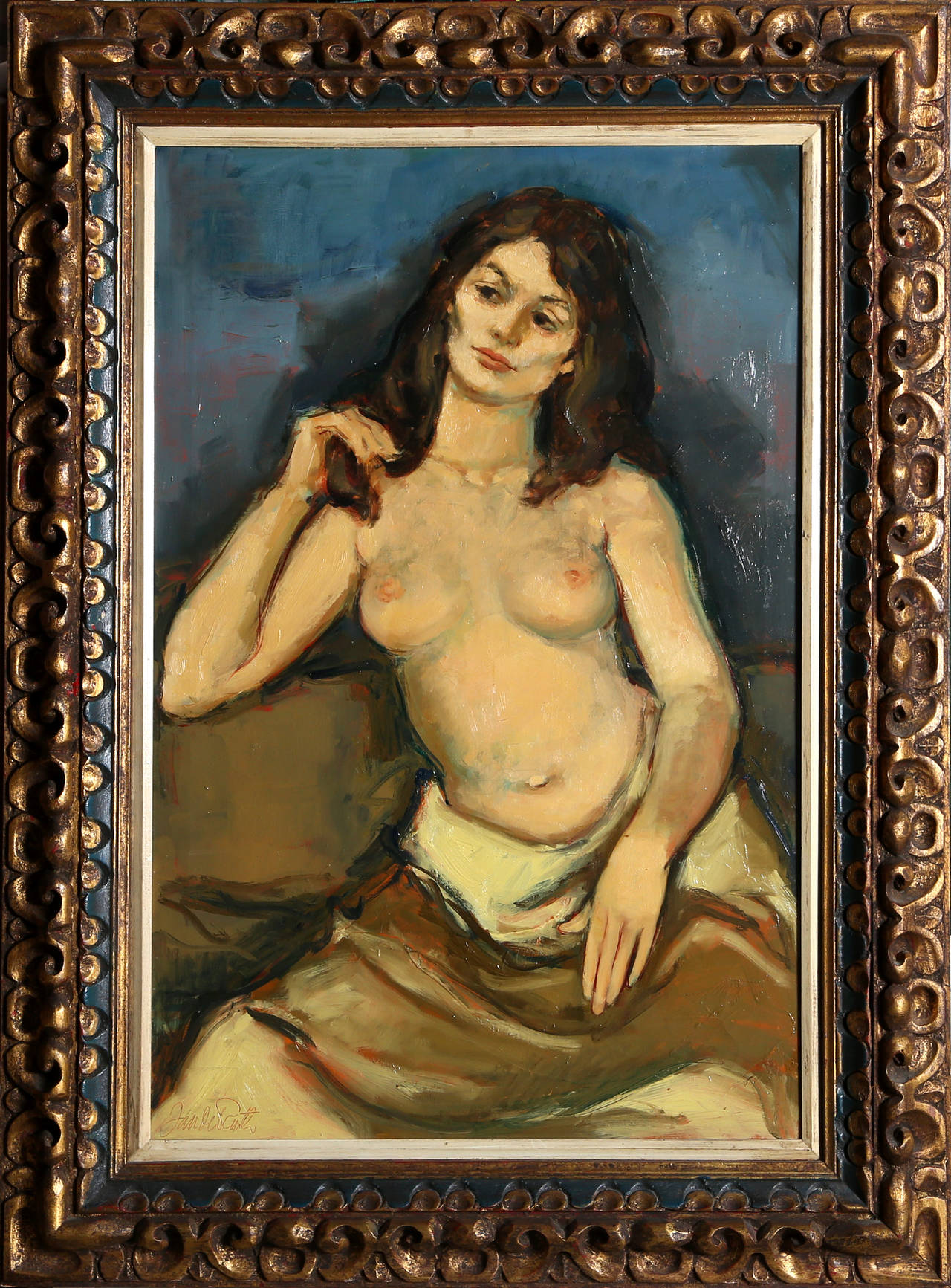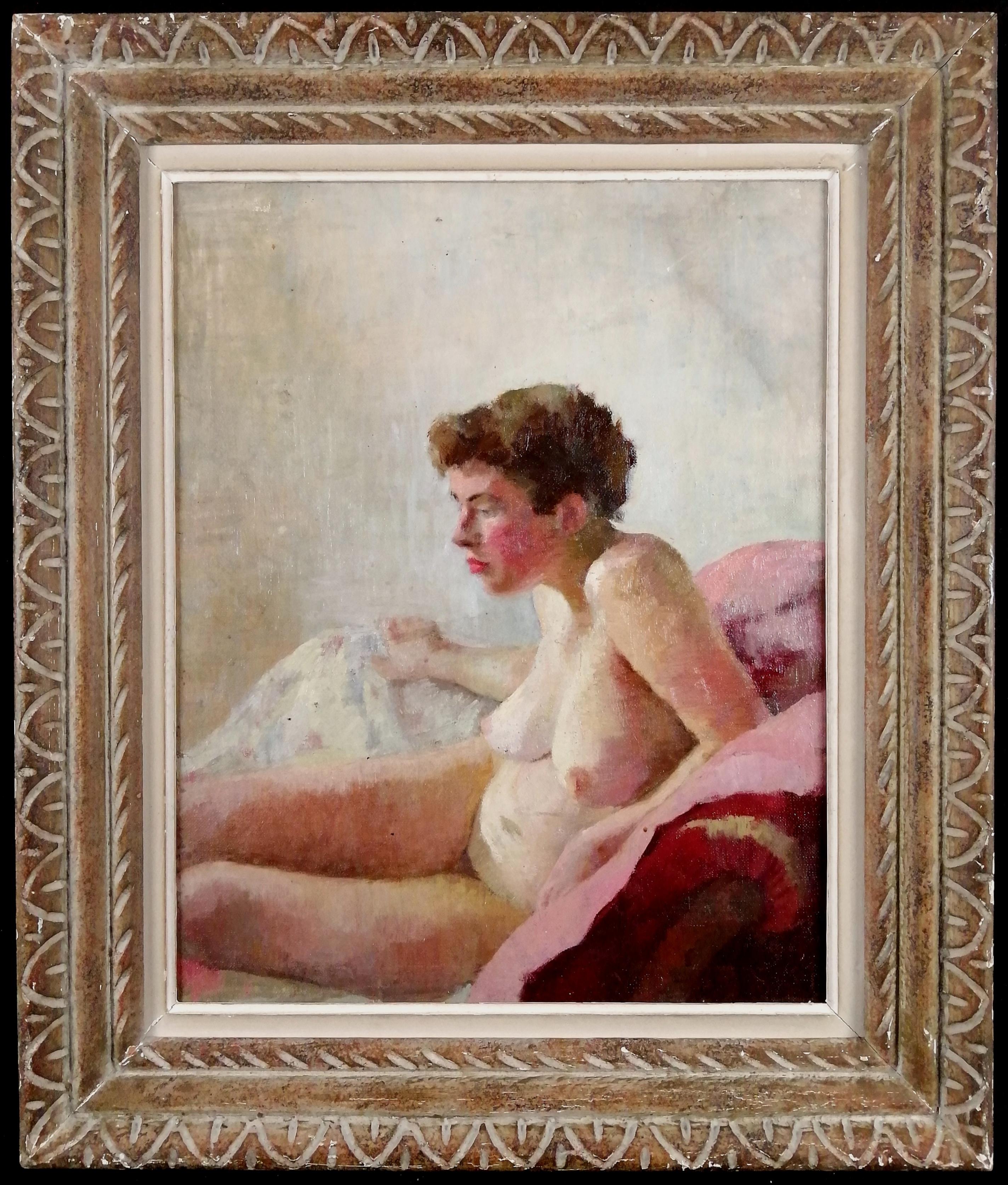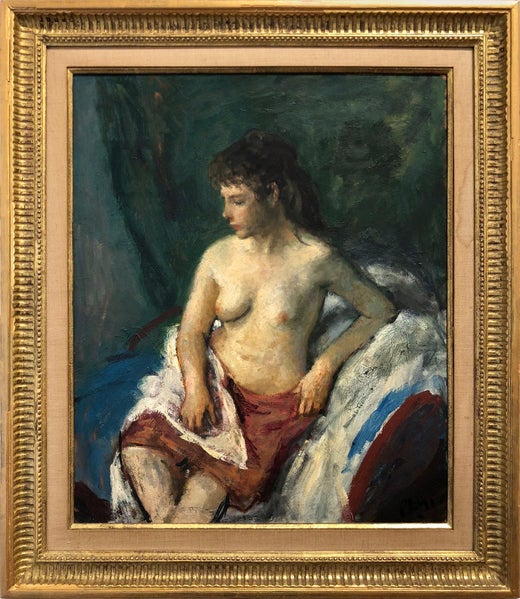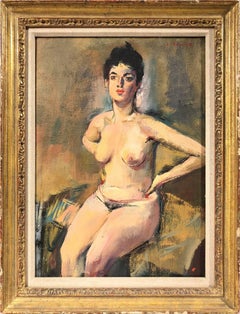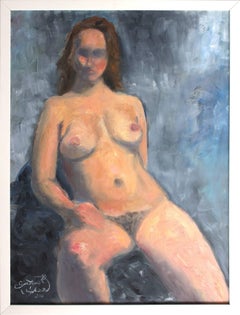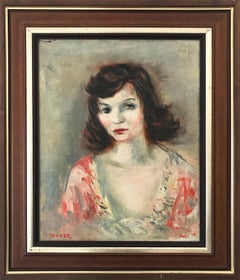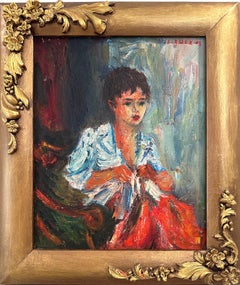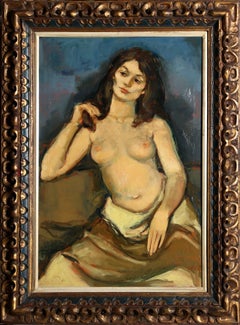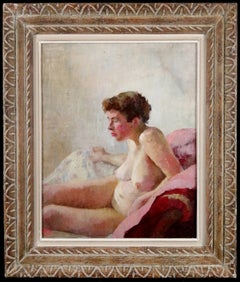Items Similar to "Portrait of a Seated Nude Woman" American Impressionist Painting Oil on Panel
Want more images or videos?
Request additional images or videos from the seller
1 of 24
Robert Philipp"Portrait of a Seated Nude Woman" American Impressionist Painting Oil on PanelCirca 1940
Circa 1940
$4,000
£3,035.11
€3,470.37
CA$5,586.92
A$6,211.89
CHF 3,243.51
MX$75,613.82
NOK 41,385.72
SEK 38,776.45
DKK 25,900.04
Shipping
Retrieving quote...The 1stDibs Promise:
Authenticity Guarantee,
Money-Back Guarantee,
24-Hour Cancellation
About the Item
A rare and breath taking work, with masterful bursh work and sublime execution of light. We are drawn to the subtle beauty and elegant pose. The tasteful compostion lends an intimate scene into the artists studio where Philip has captured her effortlessly. This piece comes displayed in a wonderful frame and hanging wire on verso.
Art measures 24 x 20 inches
Frame measures 30 x 26 inches
Robert Philipp was born on February 2, 1895 in New York City. He was an American painter influenced by Impressionism and Post-Impressionism, and known for his nudes, still lifes, and portraits of attractive women and Hollywood stars. Moses Solomon Philipp showed early talent and grew up in a family atmosphere that fed and cultivated his creativity. At age of 15, he entered the Art Students League for four years and then continued his training at the National Academy of Design. His teachers at the League included George Bridgeman and Frank DuMond, and at the National Academy he studied with Douglas Volk and George Willoughby Maynard.
After the death of his father, Philipp turned away from painting for a time and joined his uncle's opera company as a tenor. He eventually returned to painting and settled in Paris, living there in the 1920s. The exact date of Paris sojourn is not known, but he reportedly lived there for ten years, supporting himself through the sale of his paintings. Back in New York in the early 1930s, Philipp was gaining a reputation for his portraits and figure studies. His - Olympia - won the Logan prize at the Art Institute of Chicago in 1936 and was subsequently purchase by J. Paul Getty. During the Depression, he worked for the Public Works of Arts Project. In 1934, he married artist Shelly (Rochelle) Post, who became his favorite model until her death in 1971. Critic Henry McBride called Philipp "One of the top ten painters in America." It was during the 1930s that he began to paint landscapes, still lives and nudes evolving a distinctively lyric and modern style.
Philipp painted passionately and directly creating a synthesis of observation and poetic vision using high keyed colors and rhythmic treatment of form. Philipp's work, in his later years, began to increasingly resemble the Expressionist and emotional style of Chaim Soutine. He conveyed his subjects with a certain sensitivity and understanding that his viewers could relate to. Philipp, as a teacher at the Art Students League for over thirty years and at the National Academy for sixteen years, was an important influence on American art. As a teacher, he was well known for his attention to color and his constant emphasis on the importance of drawing. He was a member of the Lotus Club, National Academy of Design and Royal Society of Arts.
Philipp taught at the High Museum of Art, 1946; University of Illinois, 1940; Art Students' League of New York and the National Academy of design. He was also elected an associate of the National Academy and later full Academician of the National Academy of Design. He won numerous awards during his life including the third Hallgarten Prize, 1922; prizes from the National Academy of Design, 1947 and 1951; Laguna Beach Art Association prize; medal prize, Art Institute of Chicago, 1936; IBM, 1939; bronze medal, Allied Artists of America, 1958 and others. Robert Philipp passed away in 1981.
PROVENANCE: Lilac Gallery Collection. This original artwork includes a Certificate of Authenticity issued by the Gallery. The piece is signed by the artist lower right and stamped from Lilac Gallery on its verso.
- Creator:Robert Philipp (1895-1981, American)
- Creation Year:Circa 1940
- Dimensions:Height: 30 in (76.2 cm)Width: 26 in (66.04 cm)Depth: 2 in (5.08 cm)
- Medium:
- Movement & Style:
- Period:
- Condition:With ordinary wear from age, otherwise, this painting is in very good condition for the time period, and comes displayed in an original antique frame that shows some ordinary wear from age and minor imperfections like water damage on the linen inner.
- Gallery Location:New York, NY
- Reference Number:Seller: 0013191stDibs: LU9823218363
Robert Philipp
Robert Philipp was a portrait, figure and still-life painter. He painted celebrities, landscapes and nudes. Philipp often used his wife, Shelby Post, as a model in his paintings. His concepts and teaching methods inspired several students whom he taught at the Art Students League in New York from 1948–73 and at the National Academy of Design from 1950–75. Philipp's works are on display at the Metropolitan Museum of Art and the Whitney Museum in New York.
About the Seller
5.0
Platinum Seller
Premium sellers with a 4.7+ rating and 24-hour response times
Established in 2012
1stDibs seller since 2015
1,759 sales on 1stDibs
Typical response time: 1 hour
- ShippingRetrieving quote...Shipping from: New York, NY
- Return Policy
Authenticity Guarantee
In the unlikely event there’s an issue with an item’s authenticity, contact us within 1 year for a full refund. DetailsMoney-Back Guarantee
If your item is not as described, is damaged in transit, or does not arrive, contact us within 7 days for a full refund. Details24-Hour Cancellation
You have a 24-hour grace period in which to reconsider your purchase, with no questions asked.Vetted Professional Sellers
Our world-class sellers must adhere to strict standards for service and quality, maintaining the integrity of our listings.Price-Match Guarantee
If you find that a seller listed the same item for a lower price elsewhere, we’ll match it.Trusted Global Delivery
Our best-in-class carrier network provides specialized shipping options worldwide, including custom delivery.More From This Seller
View All"Seated Nude" American Impressionist Portrait of a Woman Oil on Board Painting
By Louis Bouché
Located in New York, NY
This is a wonderful example of Louis Bouché's charming Nude portraits. The artist was truly a master of capturing the energy of the times, and character o...
Category
Mid-20th Century American Impressionist Nude Paintings
Materials
Board, Oil
$2,800 Sale Price
30% Off
"Nude in the Studio" Impressionistic Oil Painting on Board of a Nude Woman
By Cindy Shaoul
Located in New York, NY
A depiction of a young nude woman seated laid back and posing. A romantic air is felt throughout this piece with a dreamy atmosphere and lush colors. She has dark brown hair, wears d...
Category
2010s Impressionist Figurative Paintings
Materials
Oil, Board
"Portrait of a Young Lady" Post-Impressionism French Oil Painting on Canvas
By Jacques Zucker
Located in New York, NY
This painting depicts a whimsical portrait of a young lady posing with an alluring look in a colorful blouse. The bright colors and quick brush strokes are what makes this painting s...
Category
1960s Post-Impressionist Figurative Paintings
Materials
Canvas, Oil
"Girl Sewing" Post-Impressionist Portrait of Seated Girl Oil Painting on Canvas
By Jacques Zucker
Located in New York, NY
An outstanding oil painting depicting a portrait of a seated girl sewing. The subtle tones and bright pops of colors are what makes this piece so attractiv...
Category
20th Century Post-Impressionist Portrait Paintings
Materials
Oil, Canvas
"Young Self Portrait" Post-Impressionism French Oil Painting on Board of Figure
By Jacques Zucker
Located in New York, NY
This painting depicts a whimsical portrait of a self-portrait of the artist at a younger age. The bright colors and quick brush strokes are what makes this painting so attractive and...
Category
Mid-20th Century Post-Impressionist Figurative Paintings
Materials
Oil, Board
"Sun Bather by the Lake" Post-Impressionist Nude Oil Painting on Canvas Framed
By Jacques Zucker
Located in New York, NY
This painting depicts a whimsical scene of a nude sun bather resting by the lake with the trees and vegetation on the background. The bright colors and quick brush strokes are what m...
Category
20th Century Post-Impressionist Landscape Paintings
Materials
Oil, Canvas
You May Also Like
'Classical Seated Female Nude', by Charles G. Bockman, Oil on Canvas Painting
Located in Oklahoma City, OK
This 38 x 32 inch painting, is an oil on canvas titled 'Female Nude,' by artist Charles G. Bockmann. The painting depicts a 3/4th portrait of a nude woman wh...
Category
Early 20th Century Academic Figurative Paintings
Materials
Canvas, Oil
Seated Nude, Modern Oil Painting by Jan De Ruth
By Jan De Ruth
Located in Long Island City, NY
Artist: Jan De Ruth, Czech (1922 - 1991)
Title: Seated Nude
Year: circa 1960
Medium: Oil on Canvas, signed lower left
Size: 36 in. x 24 in. (91.44 cm x...
Category
1960s American Realist Nude Paintings
Materials
Oil
Seated Nude - Early 20th Century English Impressionist Portrait Oil Painting
Located in Sevenoaks, GB
* No US duty or taxes to pay on this item *
A beautiful 1930's English impressionist oil on canvas depicting a nude lady seated on a chaise longue.
Very good quality portrait of th...
Category
Early 20th Century Impressionist Portrait Paintings
Materials
Canvas, Oil
Azaki, Nude Portrait Oil on Canvas by Jan De Ruth
By Jan De Ruth
Located in Long Island City, NY
Artist: Jan De Ruth, Czech (1922 - 1991)
Title: Azaki
Year: circa 1960
Medium: Oil on Canvas, signed l.r.
Size: 36 x 24 in. (91.44 x 60.96 cm)
Frame Size: 43 x 31 inches
Category
1960s American Impressionist Nude Paintings
Materials
Canvas, Oil
Seated Female Nude Figure in Oil on Canvas
By George Wishon
Located in Soquel, CA
Seated Female Nude Figure in Oil on Canvas
Beautiful modern impressionist figure painting of a seated nude woman by George Wishon (American, 1937-2005). The two-toned light blue and...
Category
Late 20th Century American Impressionist Figurative Paintings
Materials
Canvas, Oil
1890's French Impressionist Oil Painting Studio Portrait of a Nude Lady Model
Located in Cirencester, Gloucestershire
The Studio Model
French Impressionist artist, circa 1890's
oil on canvas: 27.5 x 16.5 inches
provenance: private collection, France
condition: very good and sound condition
Category
Late 19th Century Impressionist Nude Paintings
Materials
Oil
More Ways To Browse
Robert Moses
Oil Portrait Woman 1920s
Bronze Moses
Douglas Volk
Vintage Theater Signs
Dior 1999
Blue Poster Art
1900 Multiple Prints
Magazine Covers Vogue
Stone Lithograph Prints
Framed Bird Prints
Pop Art Nyc
1954 Lithographs
Vintage Chief
Vintage Ballet Prints
Antique Nature Prints
Vintage Color Nudes
Picasso Print 1969
